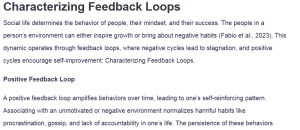Characterizing Feedback Loops
Social life determines the behavior of people, their mindset, and their success. The people in a person’s environment can either inspire growth or bring about negative habits (Fabio et al., 2023). This dynamic operates through feedback loops, where negative cycles lead to stagnation, and positive cycles encourage self-improvement: Characterizing Feedback Loops.
Positive Feedback Loop
A positive feedback loop amplifies behaviors over time, leading to one’s self-reinforcing pattern. Associating with an unmotivated or negative environment normalizes harmful habits like procrastination, gossip, and lack of accountability in one’s life. The persistence of these behaviors weakens one’s ambition and prevents personal development and, eventually, one fails to be the best version of themselves.
As motivation declines, individuals lose connections with growth-oriented friends (Ruiz et al., 2022). This isolation reinforces destructive patterns, making it harder to break free. Over time, one feels stuck in an unproductive cycle, struggling to find motivation or purpose in life.
Negative Feedback Loop
A negative feedback loop counters harmful influences by introducing positive change and also brings and maintains balance within the life of a person. Negative feedback seeks ambitions and discipline role models that inspire self-improvement and goal-setting. When one is exposed to these influences one gets encouraged toward better habits, boosting confidence and opportunities.
Success brings about further motivation, and this leads to stronger connections with like-minded people in the environment (Taborsky, 2021). Over time, this cycle takes over from negative habits with productivity, creating long-term personal and professional progress.
Social interactions are highly connected to how a person develops within the society. A positive feedback loop can trap individuals in negative habits, while a negative feedback loop helps to reduce and counteract them. When people surround themselves with supportive, growth-oriented people, individuals can break free from unproductivity and build a successful life.
References
Fabio, R. A., Chiatto, L. M., & Colombo, B. (2023). Growth mind-set and healthy behaviors in older adults. Activities Adaptation & Aging, 48(4), 613–626. https://doi.org/10.1080/01924788.2023.2252249
Ruiz, A. E., DeLong, A., & Hinton, A. (2022). Creating a positive feedback loop in leadership to accelerate cultural change. Trends in Parasitology, 38(12), 1020–1022. https://doi.org/10.1016/j.pt.2022.09.007
Taborsky, B. (2021). A positive feedback loop between sociality and social competence. Ethology, 127(10), 774–789. https://doi.org/10.1111/eth.13201
ORDER A PLAGIARISM-FREE PAPER HERE
We’ll write everything from scratch
Question
The work you have completed in this module and the ones before it has shown you many examples of models and systems that can be explained in terms of positive and negative feedback. The discussion for this module asks you to reflect on these models and explain a system in terms of feedback.
- Provide an example of an issue in any context, i.e. environmental, social, educational, or financial (that has not yet been used in the course content or presented by your peers) and explain the factors contributing to the issue.
- Represent the issue within both the context of a negative feedback loop with a balanced outcome and in a positive feedback loop with an amplified outcome
Characterizing Feedback Loops


